-
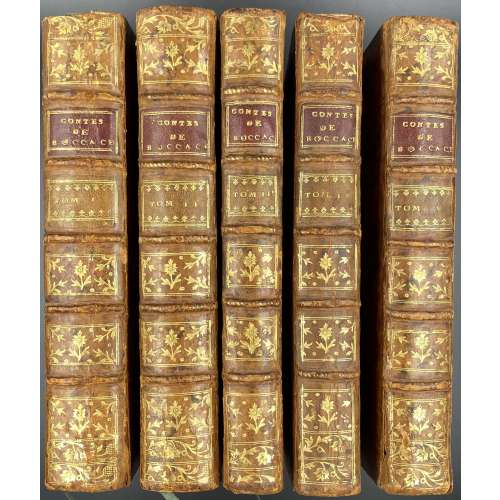 Five volumes, uniformly bound in marbled three-colour stained polished calf, spine with raised bands, gilt in compartments, crimson label with gilt lettering “CONTES DE BOCCACE”, cream label with volume number, marbled endpapers and all edges; bookplate pasted to first blank flyleaf “BIBLIOTHÈQUE DE LAJUDIE” depicting a coat of arms over an anchor, anchors and tulips scattered in the upper section, globe in the lower section, in a frame. Size: 21 x 14 cm. Translated by Antoine Le Maçon (French, 1500? – 1559). Vol. 1: [4] two blank leaves, portrait by Louis Lempereur after Hubert Gravelot, engraved t.p.: LE | DECAMERON | DE JEAN | BOCCACE. | TOME I. | Londres | 1757. | H. Gravelot Inv. […] T.P. N 21 […] J. Aliamet Sculp. ||, engraved frontispiece to Vie de Jean Bocace by Lempereur after Gravelot; Pagination: [i] ii-viii (Vie de Jean Bocace with head- and tail-pieces); [1] 2-320 [2] one blank leaf. Collation: 8vo; a4 A-V8, 164 leaves + 6 blanks + 24 plates (incl. portrait, frontis., and t.p.) extraneous to collation, 1 headpiece and 18 tailpieces. Vol. 2: [4] two blank leaves, engraved t.p.: LE | DECAMERON | DE JEAN | BOCCACE. | TOME II. | Londres 1757 | H. Gravelot inv. […] T.II. N.1. […] N. LeMire Sculp .||; Pagination: [1] 2-292 [2] one blank leaf. Collation: 8vo; A-S8 T2, 146 leaves + 3 blanks + 23 plates (incl. t.p.) extraneous to collation, and 18 tailpieces. Vol. 3: [4] two blank leaves, engraved t.p.: LE | DECAMERON | DE JEAN | BOCCACE. | TOME III. | Londres 1757 | Gravelot inv. […] T.III. N.1. […] Aillamet Sc. ||; Pagination: [1] 2-203 [204] [2] one blank leaf. Collation: 8vo; A-M8 N6, 102 leaves + 3 blanks + 23 plates (incl. t.p.) extraneous to collation, and 18 tailpieces. Vol. 4: [4] two blank leaves, engraved t.p.: LE | DECAMERON | DE JEAN | BOCCACE. | TOME IV. | Lond 1761 | Gravelot invenit […] T.IV. №.I. […] Alliamet Sculpsit. ||; Pagination: [1] 2-280 [2] one blank leaf. Collation: 8vo; A-R8 S4, 140 leaves + 3 blanks + 23 plates (incl. t.p.) extraneous to collation, and 20 tailpieces. Vol. 5: [4] two blank leaves, engraved t.p.: LE | DECAMERON | DE JEAN | BOCCACE. | TOME V. | Londres 1761 | Gravelot, inv. […] T.V. N.1. […] Aillamet Sc. ||; Pagination: [1] 2 [3] 4-269 [270] [2] one blank leaf. Collation: 8vo; A-Q8 R7, 135 leaves + 3 blanks + 23 plates (incl. t.p.) extraneous to collation, and 22 tailpieces. Total plates: 24+23+23+23+23=112; total vignettes: 19+ 18 + 18 +20 + 22 = 94; total etchings and engravings: 213. Ref: MFA ACCESSION NUMBER 37.1371a-e; Cohen-de Ricci 160; Ray, French Illustrated Book, 15 / p. 39-41; Metropolitan Museum, NY (Accession Number: 17.3.2641). Contributors: Authors: Giovanni Boccaccio (Italian, 1313–1375); Filippo Villani [Philippe-Matthieu Villani] (Italian, 1325 – 1407)Illustrated by: Hubert François Gravelot (French, 1699–1773). Artists: Charles Eisen (French, 1720–1778); François Boucher (French, 1703–1770); Charles-Nicolas Cochin le fils (French, 1715–1790), Jacques Aliamet (French, 1726–1788) Engravers: Jean Charles Baquoy (French, 1721–1777); Jean Jacques Flipart (French, 1719–1782); Louis Legrand (French, 1723–1807); Noël Le Mire (French, 1724–1801); Louis Simon Lempereur (French, 1725–1796); Catherine Elisabeth (Cousinet) Lempereur (French, born in 1726); Jean-Jacques André Le Veau (French, 1729–1786); Pierre Etienne Moitte (French, 1722–1780); Jean Ouvrier (French, 1725–1784); Jean Jacques Pasquier (French, died in 1785); Pierre (Pitre) Martenasie (Flemish, worked in France, died in 1770?); Augustin de Saint-Aubin (French, 1736–1807); Dominique Sornique (French, 1708 – 1756); Jacques Nicolas Tardieu (French, 1716–1791). Publisher: Prault (French, 18th century) Note: MFA copy has a slightly different collation: [v. 1] 152 leaves, plus plates; [v. 2] 136 ll., plus pls.; [v. 3] 98 ll., plus pls.; [v. 4] 131 ll., plus pls.; [v. 5] 124 ll., plus pls. This is their description: "First edition with these illustrations; a French translation (Cohen-de Ricci 160) appeared slightly later. Gravelot designed 89 of the 111 plates, and all 97 of the tailpieces, his largest single commission. Some 115 of his preliminary sketches by this series are in the Rosenwald Collection, Library of Congress; 131 of the final engraver's models are in the Widener Collection at the National Gallery of Art; and two other finished drawings are in the Ray Collection, Pierpont Morgan Library. Ten plates were designed by Eisen, and Cochin and Boucher had six each. As some plates in the later volumes are dated as late as 1761, the actual issuing of the volumes apparently extended to that date."
Five volumes, uniformly bound in marbled three-colour stained polished calf, spine with raised bands, gilt in compartments, crimson label with gilt lettering “CONTES DE BOCCACE”, cream label with volume number, marbled endpapers and all edges; bookplate pasted to first blank flyleaf “BIBLIOTHÈQUE DE LAJUDIE” depicting a coat of arms over an anchor, anchors and tulips scattered in the upper section, globe in the lower section, in a frame. Size: 21 x 14 cm. Translated by Antoine Le Maçon (French, 1500? – 1559). Vol. 1: [4] two blank leaves, portrait by Louis Lempereur after Hubert Gravelot, engraved t.p.: LE | DECAMERON | DE JEAN | BOCCACE. | TOME I. | Londres | 1757. | H. Gravelot Inv. […] T.P. N 21 […] J. Aliamet Sculp. ||, engraved frontispiece to Vie de Jean Bocace by Lempereur after Gravelot; Pagination: [i] ii-viii (Vie de Jean Bocace with head- and tail-pieces); [1] 2-320 [2] one blank leaf. Collation: 8vo; a4 A-V8, 164 leaves + 6 blanks + 24 plates (incl. portrait, frontis., and t.p.) extraneous to collation, 1 headpiece and 18 tailpieces. Vol. 2: [4] two blank leaves, engraved t.p.: LE | DECAMERON | DE JEAN | BOCCACE. | TOME II. | Londres 1757 | H. Gravelot inv. […] T.II. N.1. […] N. LeMire Sculp .||; Pagination: [1] 2-292 [2] one blank leaf. Collation: 8vo; A-S8 T2, 146 leaves + 3 blanks + 23 plates (incl. t.p.) extraneous to collation, and 18 tailpieces. Vol. 3: [4] two blank leaves, engraved t.p.: LE | DECAMERON | DE JEAN | BOCCACE. | TOME III. | Londres 1757 | Gravelot inv. […] T.III. N.1. […] Aillamet Sc. ||; Pagination: [1] 2-203 [204] [2] one blank leaf. Collation: 8vo; A-M8 N6, 102 leaves + 3 blanks + 23 plates (incl. t.p.) extraneous to collation, and 18 tailpieces. Vol. 4: [4] two blank leaves, engraved t.p.: LE | DECAMERON | DE JEAN | BOCCACE. | TOME IV. | Lond 1761 | Gravelot invenit […] T.IV. №.I. […] Alliamet Sculpsit. ||; Pagination: [1] 2-280 [2] one blank leaf. Collation: 8vo; A-R8 S4, 140 leaves + 3 blanks + 23 plates (incl. t.p.) extraneous to collation, and 20 tailpieces. Vol. 5: [4] two blank leaves, engraved t.p.: LE | DECAMERON | DE JEAN | BOCCACE. | TOME V. | Londres 1761 | Gravelot, inv. […] T.V. N.1. […] Aillamet Sc. ||; Pagination: [1] 2 [3] 4-269 [270] [2] one blank leaf. Collation: 8vo; A-Q8 R7, 135 leaves + 3 blanks + 23 plates (incl. t.p.) extraneous to collation, and 22 tailpieces. Total plates: 24+23+23+23+23=112; total vignettes: 19+ 18 + 18 +20 + 22 = 94; total etchings and engravings: 213. Ref: MFA ACCESSION NUMBER 37.1371a-e; Cohen-de Ricci 160; Ray, French Illustrated Book, 15 / p. 39-41; Metropolitan Museum, NY (Accession Number: 17.3.2641). Contributors: Authors: Giovanni Boccaccio (Italian, 1313–1375); Filippo Villani [Philippe-Matthieu Villani] (Italian, 1325 – 1407)Illustrated by: Hubert François Gravelot (French, 1699–1773). Artists: Charles Eisen (French, 1720–1778); François Boucher (French, 1703–1770); Charles-Nicolas Cochin le fils (French, 1715–1790), Jacques Aliamet (French, 1726–1788) Engravers: Jean Charles Baquoy (French, 1721–1777); Jean Jacques Flipart (French, 1719–1782); Louis Legrand (French, 1723–1807); Noël Le Mire (French, 1724–1801); Louis Simon Lempereur (French, 1725–1796); Catherine Elisabeth (Cousinet) Lempereur (French, born in 1726); Jean-Jacques André Le Veau (French, 1729–1786); Pierre Etienne Moitte (French, 1722–1780); Jean Ouvrier (French, 1725–1784); Jean Jacques Pasquier (French, died in 1785); Pierre (Pitre) Martenasie (Flemish, worked in France, died in 1770?); Augustin de Saint-Aubin (French, 1736–1807); Dominique Sornique (French, 1708 – 1756); Jacques Nicolas Tardieu (French, 1716–1791). Publisher: Prault (French, 18th century) Note: MFA copy has a slightly different collation: [v. 1] 152 leaves, plus plates; [v. 2] 136 ll., plus pls.; [v. 3] 98 ll., plus pls.; [v. 4] 131 ll., plus pls.; [v. 5] 124 ll., plus pls. This is their description: "First edition with these illustrations; a French translation (Cohen-de Ricci 160) appeared slightly later. Gravelot designed 89 of the 111 plates, and all 97 of the tailpieces, his largest single commission. Some 115 of his preliminary sketches by this series are in the Rosenwald Collection, Library of Congress; 131 of the final engraver's models are in the Widener Collection at the National Gallery of Art; and two other finished drawings are in the Ray Collection, Pierpont Morgan Library. Ten plates were designed by Eisen, and Cochin and Boucher had six each. As some plates in the later volumes are dated as late as 1761, the actual issuing of the volumes apparently extended to that date." -
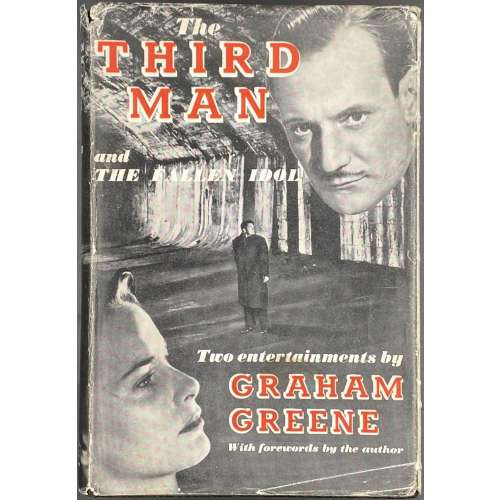 Title page: THE THIRD MAN | and | THE FALLEN IDOL | by | GRAHAM GREENE | {publisher’s device with lettering} |WILLIAM HEINEMANN LTD | MELBOURNE : : LONDON : : TORONTO || Title verso: FIRST PUBLISHED 1950 | PRINTED IN GREAT BRITAIN | AT THE WINDMILL PRESS | KINGSWOOD, SURREY || Pagination:[6] [1, 2] 3-188 [2] blank. Binding: publisher’s black cloth, silver lettering to spine, blind-stamped publisher’s device to back cover in the lower-right corner without lettering; publisher's pictorial dust jacket with lettering (white and read on b/w photo): The | THIRD | MAN | and | THE FALLEN IDOL | The entertainments by | GRAHAM | GREENE | With forewords by the author ||, price clipped. Size: 19 x 13 cm. Edition: 1st edition, 1st printing. Contributors: Graham Greene (British, 1904 – 1991) – author. William Henry Heinemann (British-Jewish, 1863 – 1920); William Heinemann Limited – publisher. The Windmill Press (Kingswood, Surrey) – printer.
Title page: THE THIRD MAN | and | THE FALLEN IDOL | by | GRAHAM GREENE | {publisher’s device with lettering} |WILLIAM HEINEMANN LTD | MELBOURNE : : LONDON : : TORONTO || Title verso: FIRST PUBLISHED 1950 | PRINTED IN GREAT BRITAIN | AT THE WINDMILL PRESS | KINGSWOOD, SURREY || Pagination:[6] [1, 2] 3-188 [2] blank. Binding: publisher’s black cloth, silver lettering to spine, blind-stamped publisher’s device to back cover in the lower-right corner without lettering; publisher's pictorial dust jacket with lettering (white and read on b/w photo): The | THIRD | MAN | and | THE FALLEN IDOL | The entertainments by | GRAHAM | GREENE | With forewords by the author ||, price clipped. Size: 19 x 13 cm. Edition: 1st edition, 1st printing. Contributors: Graham Greene (British, 1904 – 1991) – author. William Henry Heinemann (British-Jewish, 1863 – 1920); William Heinemann Limited – publisher. The Windmill Press (Kingswood, Surrey) – printer. -
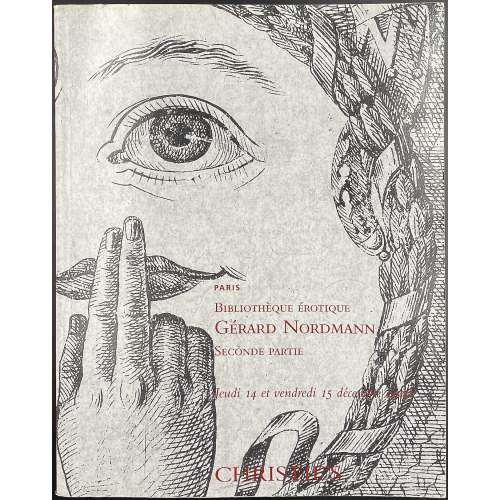 Publisher’s grey pictorial wrappers with lettering in red: PARIS | Bibliothèque érotique | Gérard Nordmann | Seconde partie | Jeudy 14 et vendredi 15 décembre 2006 | CHRISTIE'S || Red spine with white lettering from top to bottom, multiple illustrations in colour, 27 x 21 cm. Pagination: [1-3] 4-305, 567 lots. The 2nd part of the auction of the library of Gérard Nordmann (Swiss, 1930 – 1992), held by Christie's in Paris on the 14th and 15th of December 2006. The 1st part took place on the 27th of April 2006, see [LIB-2828.2021].
Publisher’s grey pictorial wrappers with lettering in red: PARIS | Bibliothèque érotique | Gérard Nordmann | Seconde partie | Jeudy 14 et vendredi 15 décembre 2006 | CHRISTIE'S || Red spine with white lettering from top to bottom, multiple illustrations in colour, 27 x 21 cm. Pagination: [1-3] 4-305, 567 lots. The 2nd part of the auction of the library of Gérard Nordmann (Swiss, 1930 – 1992), held by Christie's in Paris on the 14th and 15th of December 2006. The 1st part took place on the 27th of April 2006, see [LIB-2828.2021]. -
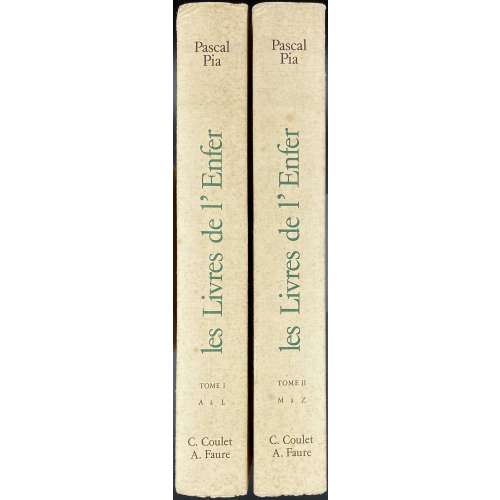 Vol. 1: Front wrapper (green and black): Pascal Pia | les | Livres | de l'Enfer | du XVIeme siècle à nos jours | TOME I | C. Coulet et A. Faure || Title page: Pascal Pia | les | Livres (historiated initial «L») | de l'Enfer | Bibliographie critique des ouvrages | érotiques dans leurs différentes | éditions du XVIe siècle à nos jours. | Tome I | A à L | C. Coulet et A. Faure | 5 rue Drouot | Paris 9e | 1978 || Pagination: [1-6] 7-413 [414]. Vol. 2: Front wrapper similar to Vol. 1 but “TOME II”; title similar to Vol. 1 but “Tome II | M à Z”. Pagination: [6] 415-837 [838] [2] – colophon / blank. Entries in the main sections are not numbered, each page has two columns of text and the columns are numbered 1-778 in vol. 1 and 779-1440 in vol. 2; p. 751– 792 – l'enfer BNF (numbered list); pp. 793-837 – index of authors, artists, editors, publishers, etc. Edition: 1st; limited to 900 copies, first 100 numbered 1-100 and printed on Ingres paper, next 800 numbered 1-800 and printed on Centaure Ivoire paper. This copy is № 34 (stamped in black) from the first hundred. Binding: 25 x 16.5 cm, both volumes printed on laid watermarked paper “Ingres”, untrimmed, uncut, uniformly bound in publisher’s wrappers lettered on front and spine. Contributors: Pascal Pia [Pierre Durand] (French, 1903 – 1979) – author/compiler. Imprimerie centrale de l'Ouest (Roche-sur-Yon) – printer.
Vol. 1: Front wrapper (green and black): Pascal Pia | les | Livres | de l'Enfer | du XVIeme siècle à nos jours | TOME I | C. Coulet et A. Faure || Title page: Pascal Pia | les | Livres (historiated initial «L») | de l'Enfer | Bibliographie critique des ouvrages | érotiques dans leurs différentes | éditions du XVIe siècle à nos jours. | Tome I | A à L | C. Coulet et A. Faure | 5 rue Drouot | Paris 9e | 1978 || Pagination: [1-6] 7-413 [414]. Vol. 2: Front wrapper similar to Vol. 1 but “TOME II”; title similar to Vol. 1 but “Tome II | M à Z”. Pagination: [6] 415-837 [838] [2] – colophon / blank. Entries in the main sections are not numbered, each page has two columns of text and the columns are numbered 1-778 in vol. 1 and 779-1440 in vol. 2; p. 751– 792 – l'enfer BNF (numbered list); pp. 793-837 – index of authors, artists, editors, publishers, etc. Edition: 1st; limited to 900 copies, first 100 numbered 1-100 and printed on Ingres paper, next 800 numbered 1-800 and printed on Centaure Ivoire paper. This copy is № 34 (stamped in black) from the first hundred. Binding: 25 x 16.5 cm, both volumes printed on laid watermarked paper “Ingres”, untrimmed, uncut, uniformly bound in publisher’s wrappers lettered on front and spine. Contributors: Pascal Pia [Pierre Durand] (French, 1903 – 1979) – author/compiler. Imprimerie centrale de l'Ouest (Roche-sur-Yon) – printer. -
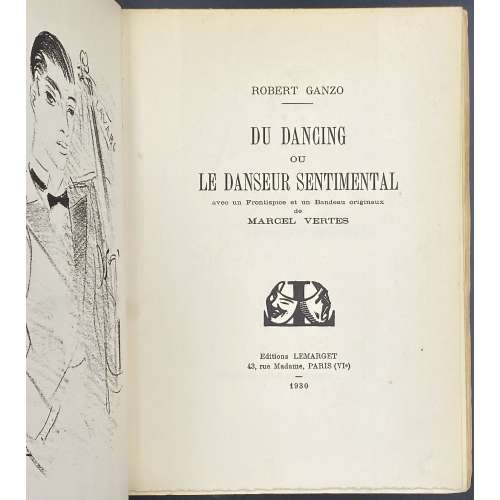 Title-page: ROBERT GANZO | DU DANCING | OU | LE DANSEUR SENTIMENTAL | avec un Frontispice et un Bandeau originaux | de | MARCEL VERTES | {publisher’s device} | Editions LEMARGET | 43, rue Madame, PARIS (VIe) | 1930.|| Description: 20.7 x 14.9 cm, French flapped cream wrappers with black and green lettering similar to title, lettering to spine “DU DANCING”; [1-13] incl. leaf in wrapper, 1st blank leaf, h.t. / limitation, frontispiece, t.p. / copyright, dedication to Gaston Guillot / blank, 14-106 [4] colophon / blank, and one leaf in wrapper; frontispiece and first chapter headpiece lithography by Vertès, plus inset of the same. Collation: 4to; [1,2]4 3-134 143; total 55 leaves. Printing: June 10, 1930, by Presses Modernes in Reims. Edition: 15 copies on Japon Impérial numbered I-XV, 20 colies on Hollande Van Gelder numbered XVI-XXXV, 250 copies on Vélin de Rives numbered 1-250, 20 of which reserved for the bookstore of H. Champion, and 25 presentation copies numbered A-Z. This copy is № XVI. Contributors: Robert Ganzo (French, 1898 – 1995) – author. Marcel Vertès [Marcell Vértes] (Jewish-Hungarian-French, 1895 – 1961) – artist. Gaston Guillot (French, 1889 – 1960) – dedicatee. Editions Lemarget (Paris) – publisher. Presses Modernes (Reims) – printer. Other names: Marcel Vertès, Marcel Vertes, Marcell Vértes
Title-page: ROBERT GANZO | DU DANCING | OU | LE DANSEUR SENTIMENTAL | avec un Frontispice et un Bandeau originaux | de | MARCEL VERTES | {publisher’s device} | Editions LEMARGET | 43, rue Madame, PARIS (VIe) | 1930.|| Description: 20.7 x 14.9 cm, French flapped cream wrappers with black and green lettering similar to title, lettering to spine “DU DANCING”; [1-13] incl. leaf in wrapper, 1st blank leaf, h.t. / limitation, frontispiece, t.p. / copyright, dedication to Gaston Guillot / blank, 14-106 [4] colophon / blank, and one leaf in wrapper; frontispiece and first chapter headpiece lithography by Vertès, plus inset of the same. Collation: 4to; [1,2]4 3-134 143; total 55 leaves. Printing: June 10, 1930, by Presses Modernes in Reims. Edition: 15 copies on Japon Impérial numbered I-XV, 20 colies on Hollande Van Gelder numbered XVI-XXXV, 250 copies on Vélin de Rives numbered 1-250, 20 of which reserved for the bookstore of H. Champion, and 25 presentation copies numbered A-Z. This copy is № XVI. Contributors: Robert Ganzo (French, 1898 – 1995) – author. Marcel Vertès [Marcell Vértes] (Jewish-Hungarian-French, 1895 – 1961) – artist. Gaston Guillot (French, 1889 – 1960) – dedicatee. Editions Lemarget (Paris) – publisher. Presses Modernes (Reims) – printer. Other names: Marcel Vertès, Marcel Vertes, Marcell Vértes -
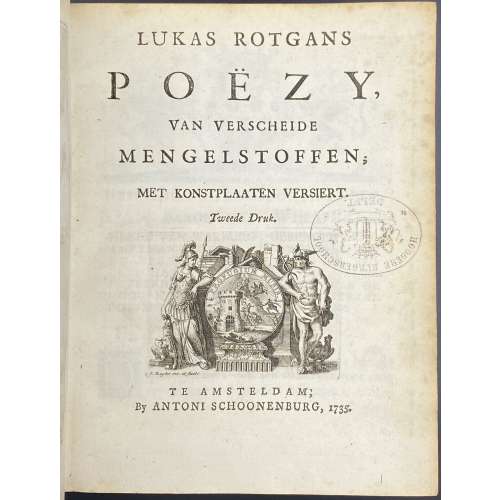 Title-page: LUKAS ROTGANS | POËZY, | VAN VERSCHEIDE | MENGELSTOFFEN; | MET KONSTPLAATEN VERSIERT. | Tweede Druk | {vignette} | TE AMSTERDAM; | By ANTONI SCHOONENBURG, 1735. || Collation: 4to; fep, 1st blank, engraved t.p. by M. Pool, t.p., *3,4; 2*-9*4, 10*1, *LII2, *LII, 10*2 —> *-10*4 (40 leaves); A-Z4, 2A-2Z4, 3A-3Z4, 4A-4Q4, last blank, fep; (340 leaves), 2 plates extraneous to collation. Pagination: [2] [1-5] 6-14 [15-80] [1-3] 4-680 [2], 2 unsigned plates not included in pagination after pp. 634 and 652, 50 headpieces by Jacob Folkema after Arnold Houbraken, and 2 tailpieces by Jan de Ruijter. Marks: Armorial bookplate: “Ex Libris J. J. Mak | {coat of arms} | Inveni Intermanere Melius”. Oval ink stamp: “HOOGERE BURGERSCHOOL. | DELFT” Provenance: Johannes Jacobus Mak (Dutch, 1908 – 1975). Edition: 2nd, 1st edition published in 1715 in Leeuwarden by François Halma. Contributors: Lukas Rotgans (Dutch, 1653 – 1710) – author. Arnold Houbraken (Dutch, 1660 – 1719) – artist. Jacob Folkema (Dutch, 1692 – 1767) – engraver. Matthijs Pool (Dutch, 1676 – 1740) – engraver. Jan de Ruijter (Dutch, 1688 – 1744) – engraver. Antoni Schoonenburg (Dutch, 1682 – 1754) – publisher.
Title-page: LUKAS ROTGANS | POËZY, | VAN VERSCHEIDE | MENGELSTOFFEN; | MET KONSTPLAATEN VERSIERT. | Tweede Druk | {vignette} | TE AMSTERDAM; | By ANTONI SCHOONENBURG, 1735. || Collation: 4to; fep, 1st blank, engraved t.p. by M. Pool, t.p., *3,4; 2*-9*4, 10*1, *LII2, *LII, 10*2 —> *-10*4 (40 leaves); A-Z4, 2A-2Z4, 3A-3Z4, 4A-4Q4, last blank, fep; (340 leaves), 2 plates extraneous to collation. Pagination: [2] [1-5] 6-14 [15-80] [1-3] 4-680 [2], 2 unsigned plates not included in pagination after pp. 634 and 652, 50 headpieces by Jacob Folkema after Arnold Houbraken, and 2 tailpieces by Jan de Ruijter. Marks: Armorial bookplate: “Ex Libris J. J. Mak | {coat of arms} | Inveni Intermanere Melius”. Oval ink stamp: “HOOGERE BURGERSCHOOL. | DELFT” Provenance: Johannes Jacobus Mak (Dutch, 1908 – 1975). Edition: 2nd, 1st edition published in 1715 in Leeuwarden by François Halma. Contributors: Lukas Rotgans (Dutch, 1653 – 1710) – author. Arnold Houbraken (Dutch, 1660 – 1719) – artist. Jacob Folkema (Dutch, 1692 – 1767) – engraver. Matthijs Pool (Dutch, 1676 – 1740) – engraver. Jan de Ruijter (Dutch, 1688 – 1744) – engraver. Antoni Schoonenburg (Dutch, 1682 – 1754) – publisher. -
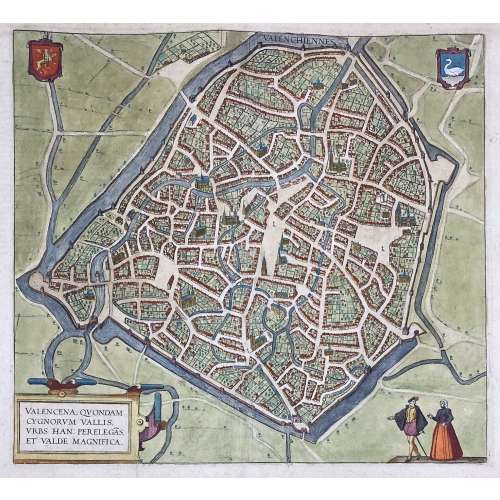 VALENCENA, QUONDAM | CYGNORUM VALLIS | URBS HAN: PERELEGÃS | ET VALDE MAGNIFICA. ||
VALENCENA, QUONDAM | CYGNORUM VALLIS | URBS HAN: PERELEGÃS | ET VALDE MAGNIFICA. ||Engraved and hand-coloured map of Valenciennes first produced for Braun & Hogenberg's 6-volume Civitates orbis terrarum edition in 1570.
English translation of the text printed on verso: "The Loire, an exceedingly well-known river in France, flows directly past the city and is very beneficial for trade. The fields surrounding the city are very fertile, and for this reason, the city is also called the granary throughout France, just as in earlier times Sicily was the granary of Rome. A famous wine also grows in this soil, which is exported from here not only throughout France but to all the countries in Europe. [...] The French spoken here is pure and uncorrupted, which is also the reason why so many foreigners settle here. For some are here for trade, others for study and others again to acquire the language, but also many without doubt for both these last two reasons, [...] and Germans, in particular, send their children here." [by Barry Lawrence Ruderman Antique Maps Inc.]
Dimensions: Sheet: 39.8 x 53.5 cm; Image: 35.2 x 38.5 cm.
Probably published in Cologne is 1612-18 by Petrum à Brachel: [Coloniae Agrippinae: apud Petrum à Brachel, sumptibus auctorum, 1612-1618]. Ref: LOC.Georg Braun [Brunus; Bruin] (German, 1541 – 1622).
Frans Hogenberg (Flemish-German, 1535 – 1590).
Abraham Ortelius [Ortels; Orthellius; Wortels] (Dutch, 1527 – 1598). -
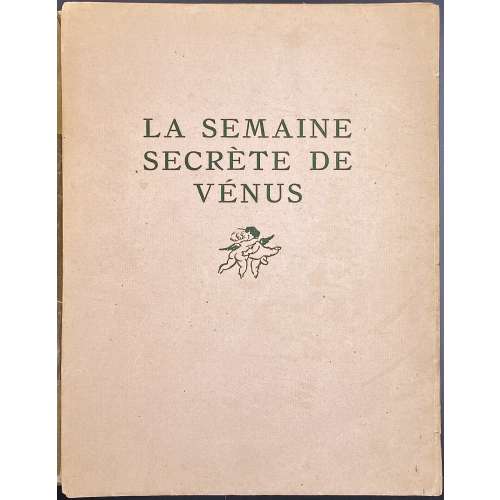 Description: Publisher’s tan French flapped wrappers, in glassine DJ, 25.4 x 19.4 cm, collated in-4to, lettered LA SEMAINE | SECRÈTE DE | VÉNUS | {fleuron} ||, outer margin uncut. Title-page: ≈ | LA SEMAINE | SECRÈTE | DE VÉNUS | Illustrée de huit Dessins | originaux reproduits en | lithographie et coloriés | {vignette} | LA CHRONIQUE CLANDESTINE | ≈ de 1919 à 1925 ≈ || Limitation: Unique copy on Vieux Japon enriched with original drawings and suites of plates, № 1-25 on Japon Imperial, enriched with 1 drawing and 3 suites of plates, № 26-275 on vélin d’Arches «avec les sept lithos en couleurs»; total print run – 275+1. This is copy № 70. Collation: π3 (blank, h.t./limit., t.p.), 1-154 χ1, total 64 leaves plus 7 plates, lithographs after drawings by Marcel Vertès, extraneous to collation. Note: Eight lithographs stated in the title are 7 plates AND a vignette on the title page. Vokaer attributes the printer/publisher as "Imprimerie Daragnès" and the year of publication as 1925. Pagination: [6] 2 blanks, 2 h.t. / limit., 2 t.p., [1-2] 3-115 [7] ; total 128 pages plus ils. Catalogue raisonné: Dutel (1920-1970): № 2386; Pia (Enfer) 1317; Nordmann (1): 246; Vokaer (1967): 8, Contributors : Pierre Mac-Orlan (French, 1882 – 1970) – author. Marcel Vertès [Marcell Vértes] (Jewish-Hungarian-French, 1895 – 1961) – artist. Paul Cotinaud – publisher (per Dutel) Coulouma (Argenteuil) – printer (per Dutel).
Description: Publisher’s tan French flapped wrappers, in glassine DJ, 25.4 x 19.4 cm, collated in-4to, lettered LA SEMAINE | SECRÈTE DE | VÉNUS | {fleuron} ||, outer margin uncut. Title-page: ≈ | LA SEMAINE | SECRÈTE | DE VÉNUS | Illustrée de huit Dessins | originaux reproduits en | lithographie et coloriés | {vignette} | LA CHRONIQUE CLANDESTINE | ≈ de 1919 à 1925 ≈ || Limitation: Unique copy on Vieux Japon enriched with original drawings and suites of plates, № 1-25 on Japon Imperial, enriched with 1 drawing and 3 suites of plates, № 26-275 on vélin d’Arches «avec les sept lithos en couleurs»; total print run – 275+1. This is copy № 70. Collation: π3 (blank, h.t./limit., t.p.), 1-154 χ1, total 64 leaves plus 7 plates, lithographs after drawings by Marcel Vertès, extraneous to collation. Note: Eight lithographs stated in the title are 7 plates AND a vignette on the title page. Vokaer attributes the printer/publisher as "Imprimerie Daragnès" and the year of publication as 1925. Pagination: [6] 2 blanks, 2 h.t. / limit., 2 t.p., [1-2] 3-115 [7] ; total 128 pages plus ils. Catalogue raisonné: Dutel (1920-1970): № 2386; Pia (Enfer) 1317; Nordmann (1): 246; Vokaer (1967): 8, Contributors : Pierre Mac-Orlan (French, 1882 – 1970) – author. Marcel Vertès [Marcell Vértes] (Jewish-Hungarian-French, 1895 – 1961) – artist. Paul Cotinaud – publisher (per Dutel) Coulouma (Argenteuil) – printer (per Dutel). -
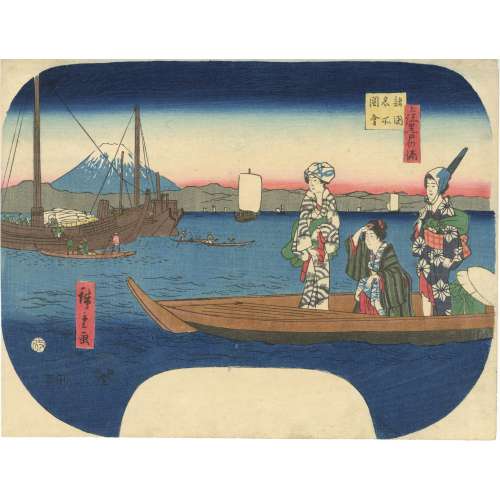 The Bay of Kuroto in Kazusa province [Kazusa Kuroto no ura] – an uncut fan print showing "Three women, wearing stylish cotton summer robes are shown in a skiff, admiring the view of Mount Fuji while looking back at the other passengers being helped into small boats". From the series: Views of famous places in the provinces [Shokoku meisho zue]. Ref: Sebastian Izzard. Important Japanese Prints 1830–1860 March 14–20, 2020 exhibition [LIB-2398.2020], №. 53. Not in Faulkner's Hiroshige Fan Prints, however, there are three other prints from the series, under № 95, 96 and 97 on p. 95. Artist: Utagawa Hiroshige [歌川 広重] a.k.a. Andō Hiroshige [安藤 広重] (Japanese, 1797 – 1858). Publisher: Iseya Sōemon [伊勢屋惣右衛門] (Japanese, c. 1776 – 1862). Date seal: 2/1855 Signed: Hiroshige ga. Censor's seal: aratame (certified) and date. Publisher's seal: Iseya Sōemon. Size: Aiban yoko-e uchiwa-e; 22.9 x 29.8 cm
The Bay of Kuroto in Kazusa province [Kazusa Kuroto no ura] – an uncut fan print showing "Three women, wearing stylish cotton summer robes are shown in a skiff, admiring the view of Mount Fuji while looking back at the other passengers being helped into small boats". From the series: Views of famous places in the provinces [Shokoku meisho zue]. Ref: Sebastian Izzard. Important Japanese Prints 1830–1860 March 14–20, 2020 exhibition [LIB-2398.2020], №. 53. Not in Faulkner's Hiroshige Fan Prints, however, there are three other prints from the series, under № 95, 96 and 97 on p. 95. Artist: Utagawa Hiroshige [歌川 広重] a.k.a. Andō Hiroshige [安藤 広重] (Japanese, 1797 – 1858). Publisher: Iseya Sōemon [伊勢屋惣右衛門] (Japanese, c. 1776 – 1862). Date seal: 2/1855 Signed: Hiroshige ga. Censor's seal: aratame (certified) and date. Publisher's seal: Iseya Sōemon. Size: Aiban yoko-e uchiwa-e; 22.9 x 29.8 cm -
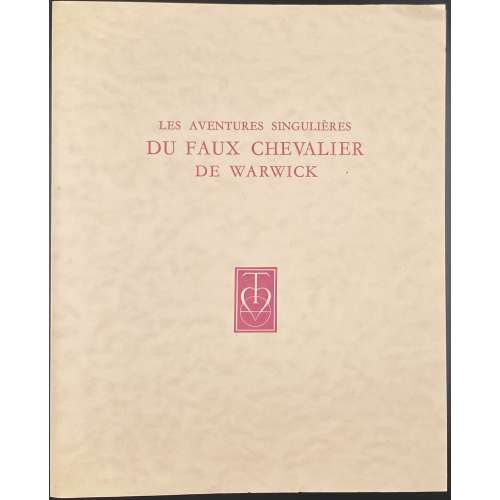 Description: One volume in publisher’s pink wrappers (folder), 24 x 19.5 cm, lettered "LES AVENTURES SINGULIÈRES | DU FAUX CHEVALIER | DE WARWICK" with the device below, in a double slipcase 25 x 20.2 cm with a lettered label to spine; collated 14 gatherings of 4 leaves and 5 gathering of 6 leaves, total 86 leaves, unbound; pp.: [10] 11-161 [162] [10], total 172 pages; illustrated with 8 full-page and 8 in-text coloured collotype reproductions after watercolours by André Collot and enriched with a suite of the same 16 plates before colouring. Text and illustrations in a purple frame, printed on wove paper watermarked “Arches”. Title-page (purple and black, in purple frame): DUPRÉ D'AULNAY | LES AVENTURES SINGULIÈRES | DU FAUX CHEVALIER | DE WARWICK | présentées par Jacques Perret | et illustrées de | 16 compositions originales | par | ANDRÉ COLLOT | {publisher’s device} | LA TRADITION | PARIS || Limitation: Edition is limited to 530 copies; first 128 copies on Vélin d’Arches, incl. 16 copies (№ 1-16) enriched with a suite before colouring and an original watercolour; 16 copies (№ 7-32) enriched with a suite before colouring and an original sketch; 96 copies (№ 33-128) enriched with a suite before colouring; 372 copies (№ 129-500) on Crèvecœur du Marais; plus 30 copies not for sale numbered I-XXX. This copy is № 53 (on Arches with a b/w suite). Colophon: Printed under the direction of Paul Durupt and Gerard Ribot on October 15, 1958, in the press of Pierre Larrive. Illustrations reproduced by Duval (Paris) and coloured by Le Coloris Moderne; bound by La Reliure Randeynes S.A. (Paris). Contributors: Louis Dupré d'Aulnay (French, 1670 – 1758) – author Jacques Perret (French, 1901 – 1992) – author André Collot (French, 1897 – 1976) – artist.
Description: One volume in publisher’s pink wrappers (folder), 24 x 19.5 cm, lettered "LES AVENTURES SINGULIÈRES | DU FAUX CHEVALIER | DE WARWICK" with the device below, in a double slipcase 25 x 20.2 cm with a lettered label to spine; collated 14 gatherings of 4 leaves and 5 gathering of 6 leaves, total 86 leaves, unbound; pp.: [10] 11-161 [162] [10], total 172 pages; illustrated with 8 full-page and 8 in-text coloured collotype reproductions after watercolours by André Collot and enriched with a suite of the same 16 plates before colouring. Text and illustrations in a purple frame, printed on wove paper watermarked “Arches”. Title-page (purple and black, in purple frame): DUPRÉ D'AULNAY | LES AVENTURES SINGULIÈRES | DU FAUX CHEVALIER | DE WARWICK | présentées par Jacques Perret | et illustrées de | 16 compositions originales | par | ANDRÉ COLLOT | {publisher’s device} | LA TRADITION | PARIS || Limitation: Edition is limited to 530 copies; first 128 copies on Vélin d’Arches, incl. 16 copies (№ 1-16) enriched with a suite before colouring and an original watercolour; 16 copies (№ 7-32) enriched with a suite before colouring and an original sketch; 96 copies (№ 33-128) enriched with a suite before colouring; 372 copies (№ 129-500) on Crèvecœur du Marais; plus 30 copies not for sale numbered I-XXX. This copy is № 53 (on Arches with a b/w suite). Colophon: Printed under the direction of Paul Durupt and Gerard Ribot on October 15, 1958, in the press of Pierre Larrive. Illustrations reproduced by Duval (Paris) and coloured by Le Coloris Moderne; bound by La Reliure Randeynes S.A. (Paris). Contributors: Louis Dupré d'Aulnay (French, 1670 – 1758) – author Jacques Perret (French, 1901 – 1992) – author André Collot (French, 1897 – 1976) – artist. -
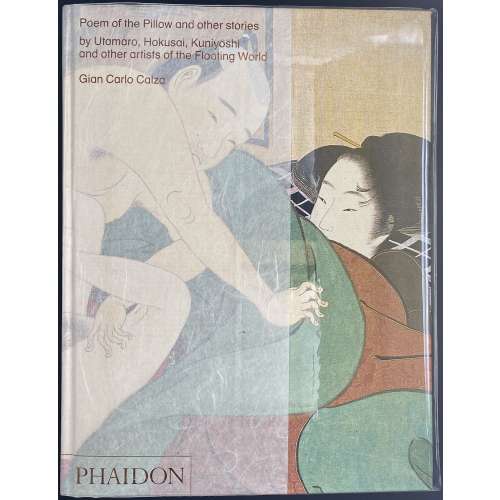 A pictorial album with almost no information (coffee-table book), hardcover, 28 x 21 x 4.8 cm, in pictorial paper boards, lettered all over, in transparent plastic dust jacket; pp.: [1-5] 6-463 [464 colophon], total 232 leaves, illustrated in colour throughout. Title-page: Poem of the Pillow and other stories | by Utamaro, Hokusai, Kuniyoshi | and other artists of the Floating World | Gian Carlo Calza | In collaboration with Stefania Piotti | {publisher’s device “Φ” in the bottom} || Contributors: Gian Carlo Calza (Italian, b. 1940); Stefania Piotti (Italian).
A pictorial album with almost no information (coffee-table book), hardcover, 28 x 21 x 4.8 cm, in pictorial paper boards, lettered all over, in transparent plastic dust jacket; pp.: [1-5] 6-463 [464 colophon], total 232 leaves, illustrated in colour throughout. Title-page: Poem of the Pillow and other stories | by Utamaro, Hokusai, Kuniyoshi | and other artists of the Floating World | Gian Carlo Calza | In collaboration with Stefania Piotti | {publisher’s device “Φ” in the bottom} || Contributors: Gian Carlo Calza (Italian, b. 1940); Stefania Piotti (Italian).
List of the artists: The Kanbun Master, Hishikawa Moronobu, Sugimura Jihei, Torii Kiyonobu I, Nishikawa Sukenobu, Miyagawa Chōshun, Okumura Masanobu, Tsukioka Settei, Suzuki Harunobu, Isoda Koryūsai, Katsukawa Shunshō, Katsukawa Shunchō, Kitao Masanobu, Torii Kiyonaga, Kitagawa Utamaro, Chōbunsai Eishi, Chōkyōsai Eiri, Katsushika Hokusai, Utagawa Toyokuni, Utagawa Kunisada, Kikugawa Eizan, Keisai Eisen, Utagawa Kuniyoshi."Poem of the Pillow and Other Stories examines the artistic developments of Japanese erotic art from the ukiyo-e period, dating from the mid-seventeenth century to the end of the nineteenth century. Known by the delicate euphemism of Shunga or 'spring images', these pictures were hugely popular and admired, and are today highly collectable works of art. This book illustrates major Shunga works from important ukiyo-e masters such as Utamaro, Hokusai, Harunobu, Kunisada, Kuniyoshi and many others. World-renowned scholar Gian Carlo Calza defines these fascinating erotic works in their social, historical and artistic context, providing a broad overview of a subject that is extremely nuanced and intriguing. Beautifully illustrated with over 300 images, including woodblock prints, scrolls and paintings, this book is a perfect introduction to ukiyo-e erotic art." -
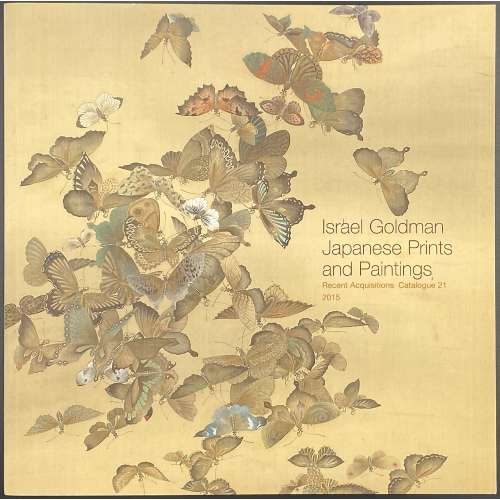 Softcover, pictorial wrappers, square 21 x 21 cm, 40 leaves, unpaginated, with illustrations in colour, 80 entries, with price list laid in; limited edition of 700 copies. Contributor: Israel Goldman In this collection:
Softcover, pictorial wrappers, square 21 x 21 cm, 40 leaves, unpaginated, with illustrations in colour, 80 entries, with price list laid in; limited edition of 700 copies. Contributor: Israel Goldman In this collection: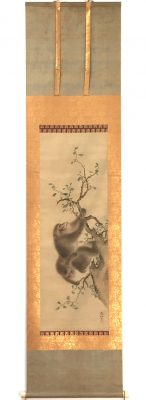
JPD-0008.2016: Mori Sosen. Ink and colour on silk.
-
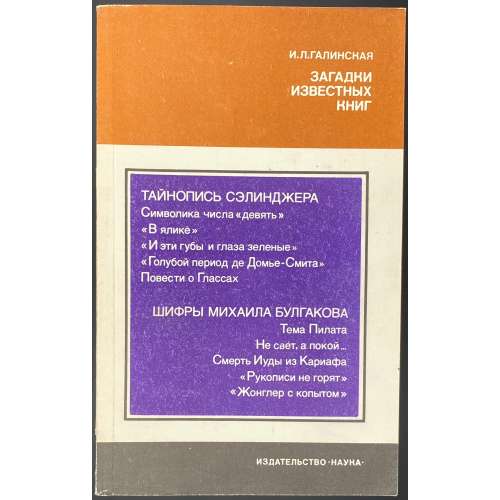 Description: Publisher’s wrappers, 20 x 12.8 cm, serial design; lettering to cover: (white on sanguine) И. Л. ГАЛИНСКАЯ | ЗАГАДКИ | ИЗВЕСТНЫХ | КНИГ | (white on aubergine, black frame) | ТАЙНОПИСЬ СЭЛИНДЖЕРА | Символика числа «девять» | «В ялике» | «И эти губы и глаза зеленые» | «Голубой период де Домье-Смита» | Повести о Глассах | ШИФРЫ МИХАИЛА БУЛГАКОВА | Тема Пилата | Не свет, а покой… | Смерть Иуды из Кариафа | «Рукописи не горят» | «Жонглер с копытом» | (white on black) ИЗДАТЕЛЬСТВО • НАУКА • || Title-page: АКАДЕМИЯ НАУК СССР | Из истории мировой культуры | И. Л. ГАЛИНСКАЯ | ЗАГАДКИ | ИЗВЕСТНЫХ | КНИГ | Ответственный редактор | доктор философских наук | И. К. ПАНТИН | {publisher’s device} | Москва | «НАУКА» | 1986 || Pagination: [2] 3-124 [125] [126 contents] [2 colophon/advert.] ; total 128 pages. Collation: 16mo; [1]-416; total 64 leaves. Print run: 142,000 copies. Contributors: Ирина Львовна Галинская [Шмарук] (Ukrainian, 1928 – 2017) Игорь Константинович Пантин (Russian, b. 1930) Михаил Афанасьевич Булгаков [Mikhail Bulgakov] (Russian, 1891 – 1940) Jerome David Salinger (American, 1919 – 2010)
Description: Publisher’s wrappers, 20 x 12.8 cm, serial design; lettering to cover: (white on sanguine) И. Л. ГАЛИНСКАЯ | ЗАГАДКИ | ИЗВЕСТНЫХ | КНИГ | (white on aubergine, black frame) | ТАЙНОПИСЬ СЭЛИНДЖЕРА | Символика числа «девять» | «В ялике» | «И эти губы и глаза зеленые» | «Голубой период де Домье-Смита» | Повести о Глассах | ШИФРЫ МИХАИЛА БУЛГАКОВА | Тема Пилата | Не свет, а покой… | Смерть Иуды из Кариафа | «Рукописи не горят» | «Жонглер с копытом» | (white on black) ИЗДАТЕЛЬСТВО • НАУКА • || Title-page: АКАДЕМИЯ НАУК СССР | Из истории мировой культуры | И. Л. ГАЛИНСКАЯ | ЗАГАДКИ | ИЗВЕСТНЫХ | КНИГ | Ответственный редактор | доктор философских наук | И. К. ПАНТИН | {publisher’s device} | Москва | «НАУКА» | 1986 || Pagination: [2] 3-124 [125] [126 contents] [2 colophon/advert.] ; total 128 pages. Collation: 16mo; [1]-416; total 64 leaves. Print run: 142,000 copies. Contributors: Ирина Львовна Галинская [Шмарук] (Ukrainian, 1928 – 2017) Игорь Константинович Пантин (Russian, b. 1930) Михаил Афанасьевич Булгаков [Mikhail Bulgakov] (Russian, 1891 – 1940) Jerome David Salinger (American, 1919 – 2010) -
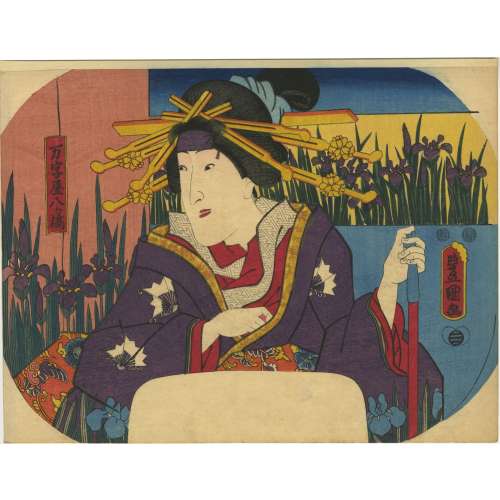 Artist: Utagawa Kunisada [歌川 国貞]; a.k.a. Utagawa Toyokuni III [三代歌川豊国] (Japanese, 1786 – 1865). Signed: Toyokuni ga [豊国 画] in a red toshidama cartouche. Publisher: Ibaya Senzaburō [伊場屋仙三郎] (Japanese, fl. C. 1845 – 1847), seal: San [三] (Marks 11-001 | 127c). Block carver: Matsushima Fusajirō [松嶋房次郎] (Japanese, fl. 1843 – 1850); seal [彫工房] – Hori kō Fusa (Gordon Friese № 134). Double nanushi censor seal: Kunigasa & Watanabe (1849-50). Actor: Iwai Hanshirō VIII [岩井半四郎] (Japanese, 1829 – 1882); other names: Iwai Shijaku II, Iwai Kumesaburō III [岩井粂三郎], Iwai Hisajirō II. Play: Yukari no Hana Iro mo Yoshiwara [紫花色吉原], performed at the Kawarazaki Theater (Edo) from the 5th day of the 5th lunar month of Kaei 3 (1850) (see Kabuki Playbill at MFA (Boston) № 11.27996).
Artist: Utagawa Kunisada [歌川 国貞]; a.k.a. Utagawa Toyokuni III [三代歌川豊国] (Japanese, 1786 – 1865). Signed: Toyokuni ga [豊国 画] in a red toshidama cartouche. Publisher: Ibaya Senzaburō [伊場屋仙三郎] (Japanese, fl. C. 1845 – 1847), seal: San [三] (Marks 11-001 | 127c). Block carver: Matsushima Fusajirō [松嶋房次郎] (Japanese, fl. 1843 – 1850); seal [彫工房] – Hori kō Fusa (Gordon Friese № 134). Double nanushi censor seal: Kunigasa & Watanabe (1849-50). Actor: Iwai Hanshirō VIII [岩井半四郎] (Japanese, 1829 – 1882); other names: Iwai Shijaku II, Iwai Kumesaburō III [岩井粂三郎], Iwai Hisajirō II. Play: Yukari no Hana Iro mo Yoshiwara [紫花色吉原], performed at the Kawarazaki Theater (Edo) from the 5th day of the 5th lunar month of Kaei 3 (1850) (see Kabuki Playbill at MFA (Boston) № 11.27996). A famous Yoshiwara courtesan named Manjiya Yatsuhashi [万字屋 八ツ橋] was killed by a provincial commoner Sano Jirōzaemon [佐野次郎左衛門] (on the second sheet of the pair):
A famous Yoshiwara courtesan named Manjiya Yatsuhashi [万字屋 八ツ橋] was killed by a provincial commoner Sano Jirōzaemon [佐野次郎左衛門] (on the second sheet of the pair):
Another Kunisada's print with the same characters in the same play and same performance can be seen at MFA (Boston) № 11.40190.
SVJP-0298.2019: Ichikawa Ebizō V as Sano Jirōzaemon.

SVJP-0297.2019: Iwai Kumesaburō III as Manjiya Yatsuhashi
 One more example can be seen in the two upper images at Waseda University Cultural Resources Database, № 006-2707:
One more example can be seen in the two upper images at Waseda University Cultural Resources Database, № 006-2707:

-
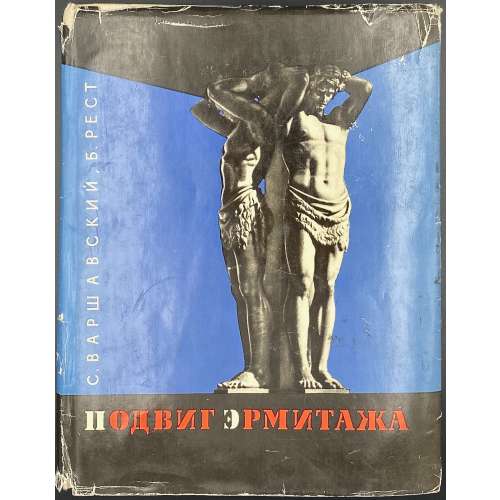 A book about the history and collections of The Hermitage museum in St. Petersburg during World War II; hardcover, 22.5 x 18 cm, in-8vo, grey cloth lettered black and red to front and spine, in pictorial dust jacket. Two similar copies of the 1st edition: LIB-3035.2022(1) and LIB-3035.2022(2). Title-page: (vertical black) С. ВАРШАВСКИЙ, Б. РЕСТ | (horizontal in red): ПОДВИГ | ЭРМИТАЖА || Opposite to t.p. (red on black): ГОСУДАРСТВЕННЫЙ | ЭРМИТАЖ | В ГОДЫ | ВЕЛИКОЙ | ОТЕЧЕСТВЕННОЙ | ВОЙНЫ || Pagination: [1-4] 5-190 [6], total 196 pages, multiple in-text b/w illustrations. Print run: 30,000 copies. Sergei Petrovich Varshavsky [Сергей Петрович Варшавский] (Jewish-Russian, 1906 – 1980). B. Rest [Б. Рест; Юлий Исаакович Шапиро] (Jewish-Russian, fl. 1940 – 1980).
A book about the history and collections of The Hermitage museum in St. Petersburg during World War II; hardcover, 22.5 x 18 cm, in-8vo, grey cloth lettered black and red to front and spine, in pictorial dust jacket. Two similar copies of the 1st edition: LIB-3035.2022(1) and LIB-3035.2022(2). Title-page: (vertical black) С. ВАРШАВСКИЙ, Б. РЕСТ | (horizontal in red): ПОДВИГ | ЭРМИТАЖА || Opposite to t.p. (red on black): ГОСУДАРСТВЕННЫЙ | ЭРМИТАЖ | В ГОДЫ | ВЕЛИКОЙ | ОТЕЧЕСТВЕННОЙ | ВОЙНЫ || Pagination: [1-4] 5-190 [6], total 196 pages, multiple in-text b/w illustrations. Print run: 30,000 copies. Sergei Petrovich Varshavsky [Сергей Петрович Варшавский] (Jewish-Russian, 1906 – 1980). B. Rest [Б. Рест; Юлий Исаакович Шапиро] (Jewish-Russian, fl. 1940 – 1980). -
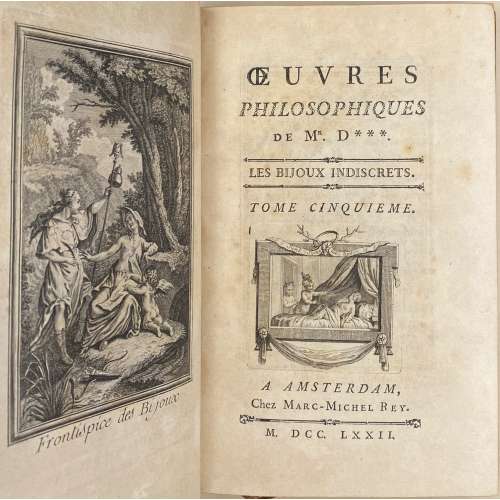 One volume, collated 8vo, 19.5 x 13 cm, later bound in brown full morocco by Pouillet, gilt-bordered covers, raised bands to spine, gilt in compartments, gilt-lettered, double-fillet on cover edges, gilt dentelle inside, signed, all edges gilt, marbled endpapers. Title-page: ŒUVRES | PHILOSOPHIQUES | DE MR. D ***. | — | LES BIJOUX INDISCRETS | — | TOME CINQUIEME | {vignette} | A AMSTERDAM, | Chez Marc-Michel Rey. | — | M. DCC. LXXII. || Pagination: [8] [1] 2-389 [390], total 398 pages, frontis., vignette, plates. Collation: 3 blank leaves at front and rear, π2 a2 A-Aa8 Bb3, total 199 leaves plus 7 unsigned engraved plates incl. frontispiece, and engraved vignette to t.p. Catalogue raisonné: Cohen-DeRicci 303; Lewine 145-6: …with the plates which have been copied and reduced in the undated Cazin edition (1771 and 1785). Contributors: Marc-Michel Rey (Dutch, 1720 – 1780) – publisher. Denis Diderot (French, 1713 – 1784) – author.
One volume, collated 8vo, 19.5 x 13 cm, later bound in brown full morocco by Pouillet, gilt-bordered covers, raised bands to spine, gilt in compartments, gilt-lettered, double-fillet on cover edges, gilt dentelle inside, signed, all edges gilt, marbled endpapers. Title-page: ŒUVRES | PHILOSOPHIQUES | DE MR. D ***. | — | LES BIJOUX INDISCRETS | — | TOME CINQUIEME | {vignette} | A AMSTERDAM, | Chez Marc-Michel Rey. | — | M. DCC. LXXII. || Pagination: [8] [1] 2-389 [390], total 398 pages, frontis., vignette, plates. Collation: 3 blank leaves at front and rear, π2 a2 A-Aa8 Bb3, total 199 leaves plus 7 unsigned engraved plates incl. frontispiece, and engraved vignette to t.p. Catalogue raisonné: Cohen-DeRicci 303; Lewine 145-6: …with the plates which have been copied and reduced in the undated Cazin edition (1771 and 1785). Contributors: Marc-Michel Rey (Dutch, 1720 – 1780) – publisher. Denis Diderot (French, 1713 – 1784) – author. -
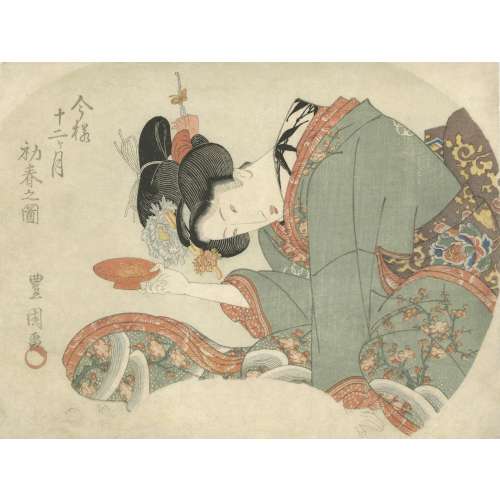 Title: Early Spring [初春之図] (Hatsuharu no zu); Series: Fashionable Twelve Months [今様十二ヶ月] (Imayo juni-kagetsu). Another version of translation: Modern Beauties of Twelve Months. Artist: Utagawa Toyokuni I [歌川豊国] (1769–1825). Pubisher: Ibaya Senzaburō [伊場屋仙三郎] (Japanese, 1815 – 1869), seal: Dansendō [伊場仙]. Signed: Toyokuni ga [豊国画] and sealed with toshidama. Date-kiwame seal: Ushi (ox), Bunsei 5 (1822). Size: double-sheet uncut fan print ( aiban uchiwa-e), each 217 x 288 mm. Ref: Tokyo Museum Collection.
Title: Early Spring [初春之図] (Hatsuharu no zu); Series: Fashionable Twelve Months [今様十二ヶ月] (Imayo juni-kagetsu). Another version of translation: Modern Beauties of Twelve Months. Artist: Utagawa Toyokuni I [歌川豊国] (1769–1825). Pubisher: Ibaya Senzaburō [伊場屋仙三郎] (Japanese, 1815 – 1869), seal: Dansendō [伊場仙]. Signed: Toyokuni ga [豊国画] and sealed with toshidama. Date-kiwame seal: Ushi (ox), Bunsei 5 (1822). Size: double-sheet uncut fan print ( aiban uchiwa-e), each 217 x 288 mm. Ref: Tokyo Museum Collection.
Other five prints of this series: SVJP 0326.2020; SVJP-0362.2022; SVJP-0363.2022; SVJP-0364.2022; SVJP-0365.2022.

-
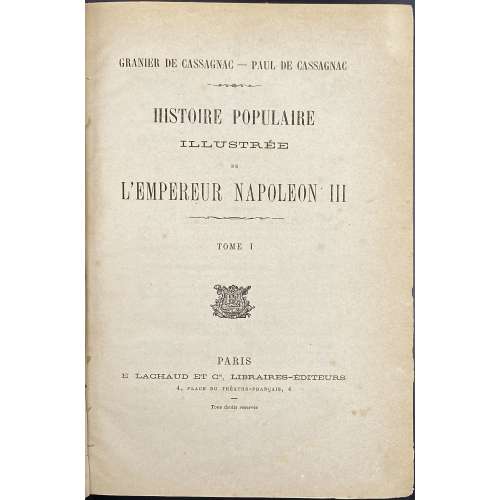 Hardcover, 28 x 20 cm, quarter sheepskin over marbled boards, marbled endpapers, gilt lettering to flat spine with gilt fillet bands, clipping pasted to front fep verso. Title-page: GRANIER DE CASSAGNAC — PAUL DE CASSAGNAC | ~ | HISTOIRE POPULAIRE | ILLUSTRÉE | DE | L'EMPEREUR NAPOLEON III | TOME I (II) | {publisher’s device} | PARIS | E. LACHAUD ET Cie, LIBRAIRES-ÉDITEURS | 4, PLACE DU THÉATRE-FRANÇAIS, 4 | – | Tous droits réservés || Collation: (v.1) π2 [1]-504, (v.2) π2 1-494; total 400 leaves plus albumen photograph pasted to frontispiece and 96 full-page woodcuts within collation. Pagination: [4] [1] 2-398 [2], [4] [1] 2-390 [2], ils.; total 800 pp. Contributors: Bernard Adolphe Granier de Cassagnac (French, 1806 – 1880) – father. Paul Adolphe Marie Prosper Granier de Cassagnac (French, 1843 – 1904) – son.
Hardcover, 28 x 20 cm, quarter sheepskin over marbled boards, marbled endpapers, gilt lettering to flat spine with gilt fillet bands, clipping pasted to front fep verso. Title-page: GRANIER DE CASSAGNAC — PAUL DE CASSAGNAC | ~ | HISTOIRE POPULAIRE | ILLUSTRÉE | DE | L'EMPEREUR NAPOLEON III | TOME I (II) | {publisher’s device} | PARIS | E. LACHAUD ET Cie, LIBRAIRES-ÉDITEURS | 4, PLACE DU THÉATRE-FRANÇAIS, 4 | – | Tous droits réservés || Collation: (v.1) π2 [1]-504, (v.2) π2 1-494; total 400 leaves plus albumen photograph pasted to frontispiece and 96 full-page woodcuts within collation. Pagination: [4] [1] 2-398 [2], [4] [1] 2-390 [2], ils.; total 800 pp. Contributors: Bernard Adolphe Granier de Cassagnac (French, 1806 – 1880) – father. Paul Adolphe Marie Prosper Granier de Cassagnac (French, 1843 – 1904) – son.


